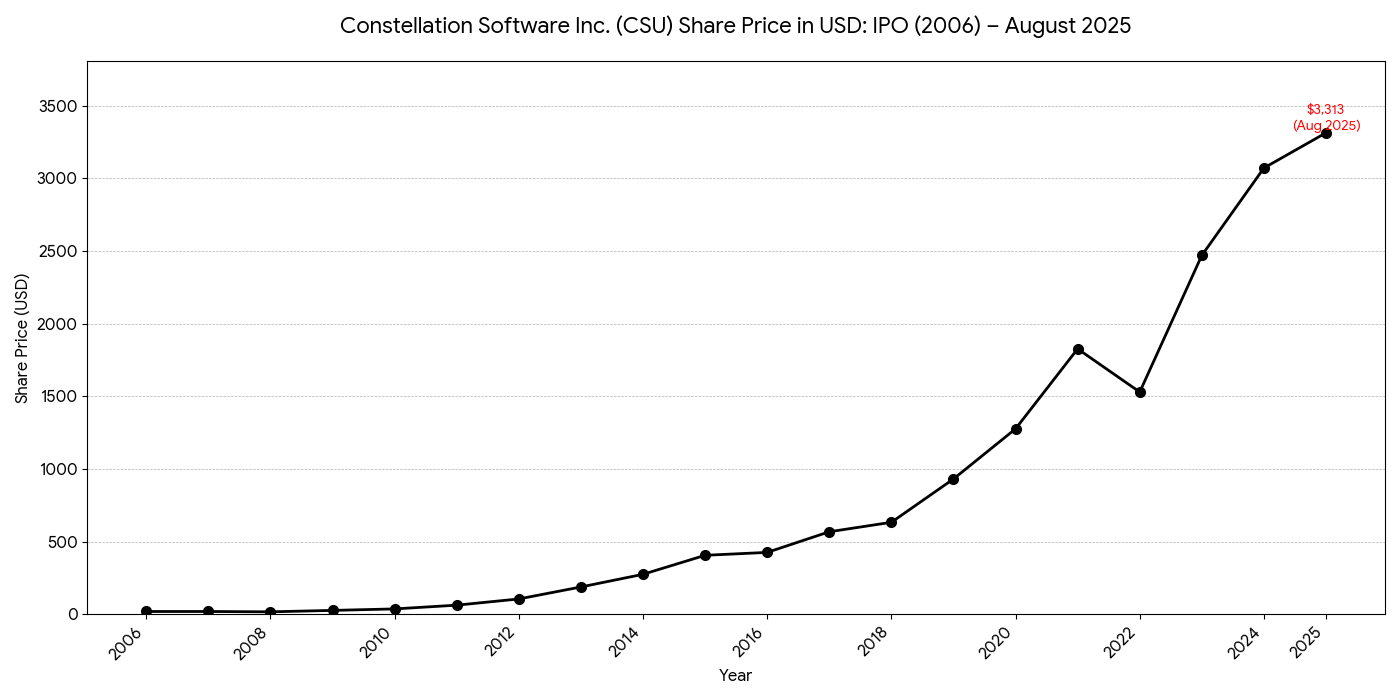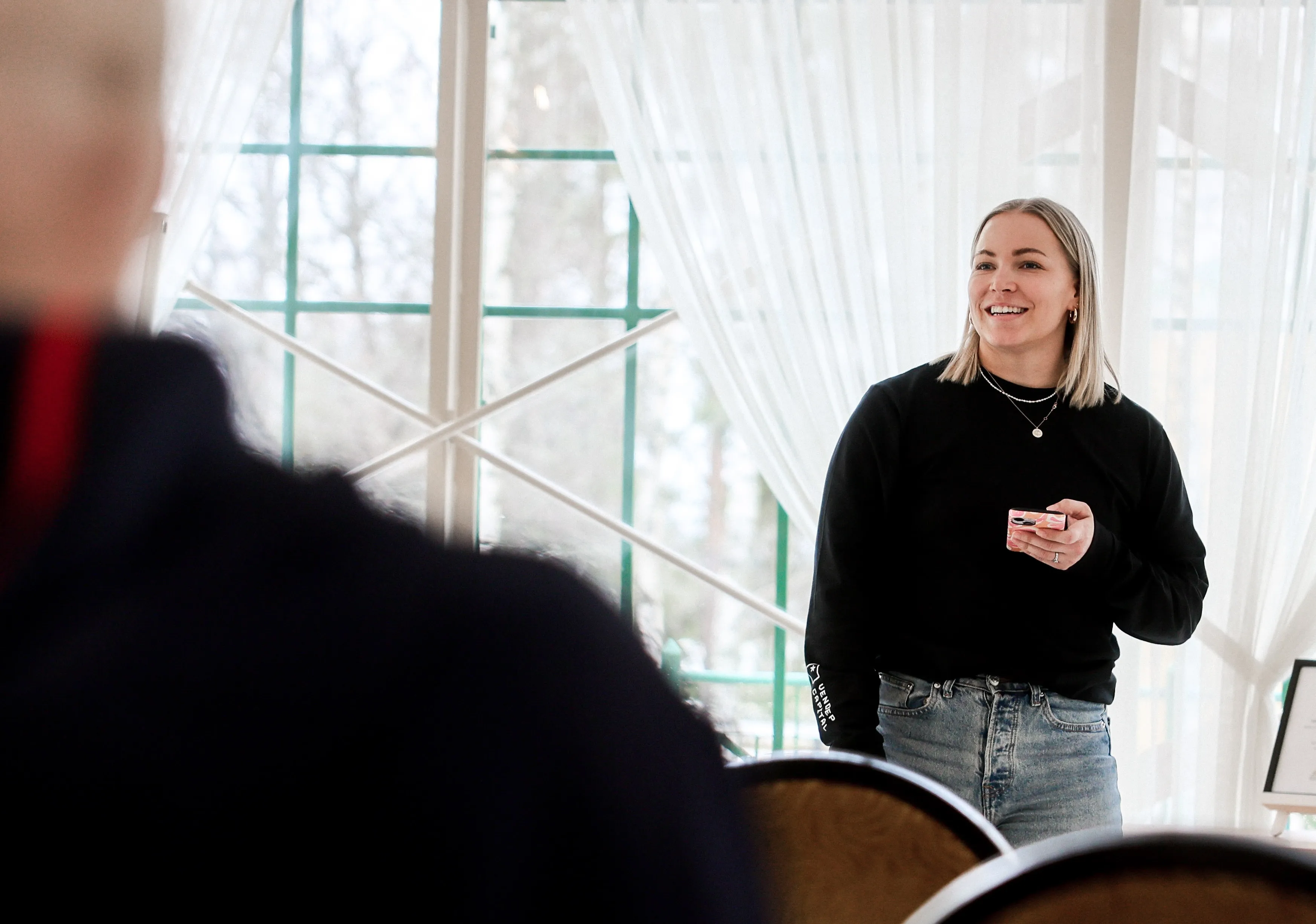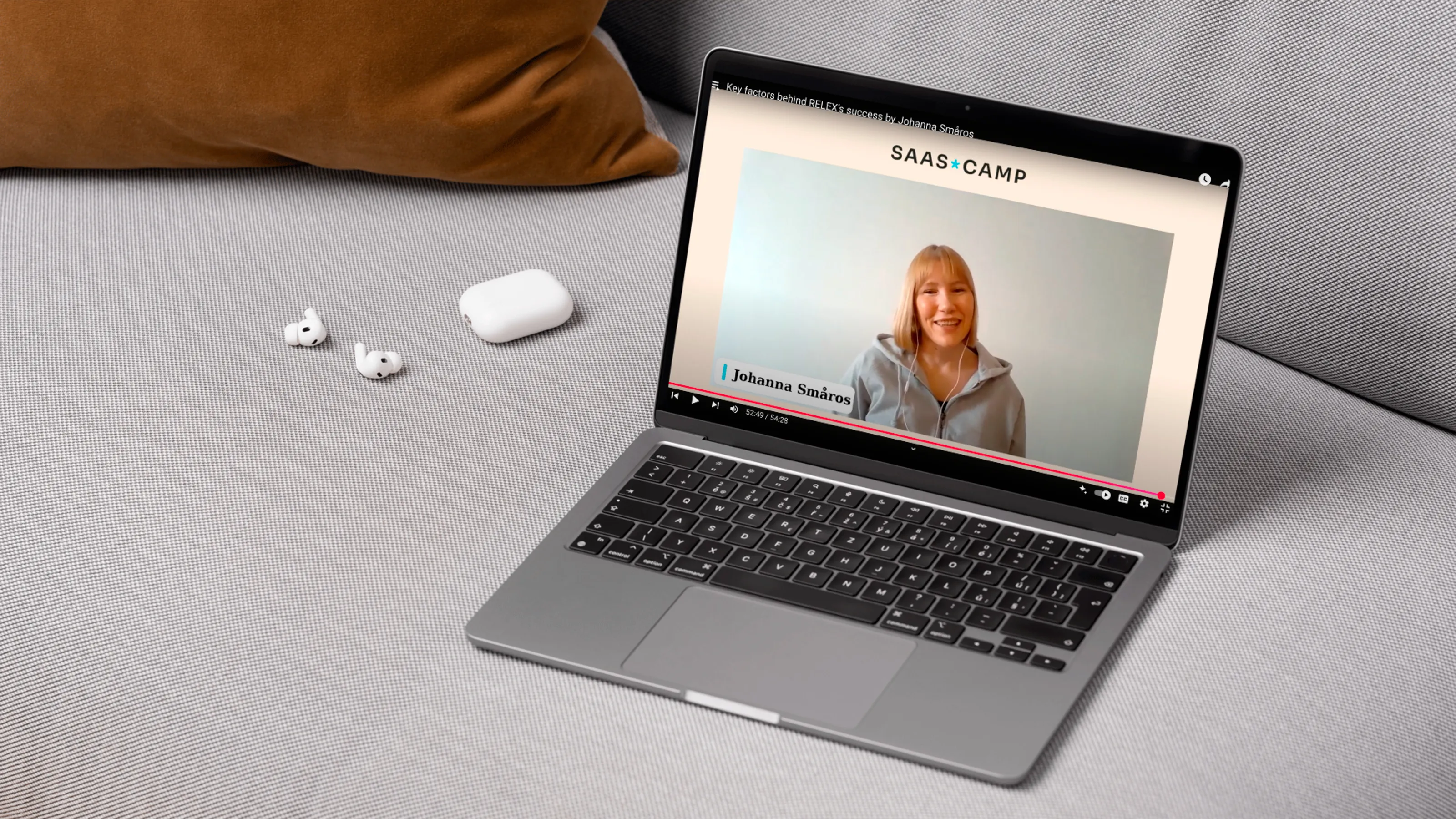For years, the VC playbook for vertical SaaS was simple: find a niche, digitize a workflow, and build a data moat.
That playbook is now under pressure.
In the age of AI, clinging to the idea of a data moat is a fatal strategic error. Foundation models have become so powerful that the advantage from proprietary data is fleeting. The real, durable, defensible asset in this new era is not the data you have, it's owning the entire workflow.
In the age of AI, clinging to the idea of a data moat is a fatal strategic error.
The companies that will win the next decade won't just sell software to the operators. They will become the operators themselves.
This is where Constellation Software ($CSU.TO) comes into play (chart below). Since its 2006 IPO, its stock has delivered a return of over 17,000%, crushing the performance of flashy tech names. Its market cap has increased from roughly $300 million to over $50 billion. How? Not by building one revolutionary platform, but by quietly acquiring over small, boring, and hyper-specific vertical SaaS companies.

The trap: Why selling vertical AI software is a two-front war
Let's be clear about the danger. Founders who continue to build traditional SaaS tools to sell to vertical industries are walking into a trap. They are being squeezed from two directions in a war that is unwinnable with the old model.
Front 1: The assault from below (commoditization by LLMs)
The giant, horizontal AI platforms (OpenAI, Google, Anthropic) are making intelligence a utility. A specific AI feature you spend six months building, like an "AI contract analyzer for real estate," can now be replicated by a user with a clever prompt. Your core technology gets commoditized, and your pricing power evaporates.
Front 2: The invasion from above (disintermediation by operators)
While you're fighting off commoditization, an AI-native operator emerges. They aren't trying to sell software, they're trying to take over the entire service layer. They buy a local accounting firm, a logistics company, or a property manager. Because they own the operation, they have advantages a software vendor can never achieve:
- Perfect implementation: They dictate AI's use from the top down.
- Unbeatable data loop: They possess a live, proprietary feed of what’s happening on the ground, the ultimate fuel for improving their AI.
- Unified margin: They capture both the software and the service margin, allowing them to offer the end service cheaper and better.
This AI-native operator consolidates the market by acquiring your customers, and since they build their own internal tech, they will never buy your software. Your addressable market shrinks until it disappears.
From System of Record to System of Consequence
Traditional SaaS created "systems of record." It was a mirror, reflecting and organizing the work happening in the real world. A CRM logs a sales call. A project management tool tracks a task's status. It’s useful, but if it breaks, the work can still get done, albeit messily. The consequence of failure is inconvenience.
AI enables something new: a System of Consequence. It doesn't just record the work, it is the conduit through which the work actually happens. If this software fails, the work stops. The consequence of failure is catastrophic.
If this software fails, the work stops. The consequence of failure is catastrophic.
Consider the construction industry. A first-generation Vertical SaaS tool might have helped a general contractor track project progress, a classic System of Record. But a company like Procore ($PCOR) evolved. It didn't just track progress, it became the platform for financial management, bidding, and creating the legally mandated audit trail for the project. If Procore goes down, work doesn't just get messy. Capital can't be deployed, and compliance is jeopardized. That is a System of Consequence.
To become indispensable, your software must evolve into a System of Consequence. Founders can achieve this by strategically entangling their software with one of three things that are non-negotiable in any business: the flow of money, the flow of physical things, or the flow of compliance.
The playbook to becoming indispensable
Software alone can still build an unbreachable moat, but it must be brave enough to take on real-world responsibility. You must become a System of Consequence by dominating one of these three pillars.
Pillar 1: Mediate the flow of money
Don't just be adjacent to your customer's revenue, become the pipeline for it. When you control the money, you control the business.
- What it looks like: You are the payment processor (Toast, $TOST), the payroll provider, the embedded lender.
- Why it's a moat: A customer can switch a scheduling app in an afternoon. They cannot switch their entire payment, payroll, and banking infrastructure over a weekend. The friction is immense.
- The AI advantage: Your AI can offer dynamic lending based on real-time cash flow, detect fraud before it happens, and automate the entire accounts payable process.
- Founder question: "What is the most critical financial event in my customer's day, and how can my software become the indispensable platform that executes it?"
Pillar 2: Mediate the flow of physical things (atoms, not bits)
Connect your software to the messy, physical reality of your customer's operations. Become the command-and-control center for their real-world assets.
- What it looks like: You are the logistics dispatch system controlling the truck's route (Samsara, $IOT). Your software is connected to IoT sensors on the factory floor. You grant physical access to a building.
- Why it's a moat: Ripping you out means re-wiring the physical world. The switching costs are tied to hardware, staff training, and established operational processes.
- The AI advantage: Your AI can optimize delivery routes based on live traffic, perform predictive maintenance on machinery, and use computer vision to enforce on-site safety protocols.
- Founder question: "What physical asset or real-world action is the bottleneck for my customer's business, and how can my software become its brain?"
Pillar 3: Mediate the flow of compliance & risk
In regulated industries, become the official, auditable system of truth. Your software must be the shield that protects the business from existential legal and financial risk.
- What it looks like: You are the system generating the legally-mandated audit trail for a construction project (Procore, $PCOR). You are the platform ensuring a financial transaction is compliant with KYC/AML laws.
- Why it's a moat: Switching away means losing the verified proof of compliance and taking on immense corporate liability. No board would approve that risk to save on a license fee.
- The AI Advantage: Your AI can scan thousands of pages of regulations to automatically flag non-compliant clauses, analyze on-site photos for safety violations, and automate the generation of complex regulatory reports.
- Founder Question: "What is the regulatory event that keeps my customer's CEO awake at night, and how can my software be the reason they can sleep soundly?"
Winning from the inside out
This new reality demands a new kind of thinking. The defining question is no longer “Do you have proprietary data?” but “How will you gain control of the workflow?” In the AI era, defensibility comes from owning the operational layer by embedding yourself in the flow of money, atoms, or compliance, not from hoarding information.
In the AI era, defensibility comes from owning the operational layer by embedding yourself in the flow of money, atoms, or compliance, not from hoarding information.
The next great companies will be built by a new archetype: the AI-enabled operator. These are systems thinkers who understand M&A, operational excellence, and capital allocation as well as code. They treat AI not as magic but as a new class of labor to be deployed with precision and efficiency.
And the real prize isn’t a SaaS multiple. It is the labor TAM – the total market for human work waiting to be automated or enhanced. The winners will not be selling software seats for $100 a month; they will be building operational engines that perform the same work 30 to 50 percent cheaper and better than the human-powered incumbents.
The last decade was about building systems of record. The next will be about building systems of consequence. The companies that thrive will not just make software; they will have the courage to build a fundamentally better version of the business itself.


.jpg)



.webp)

